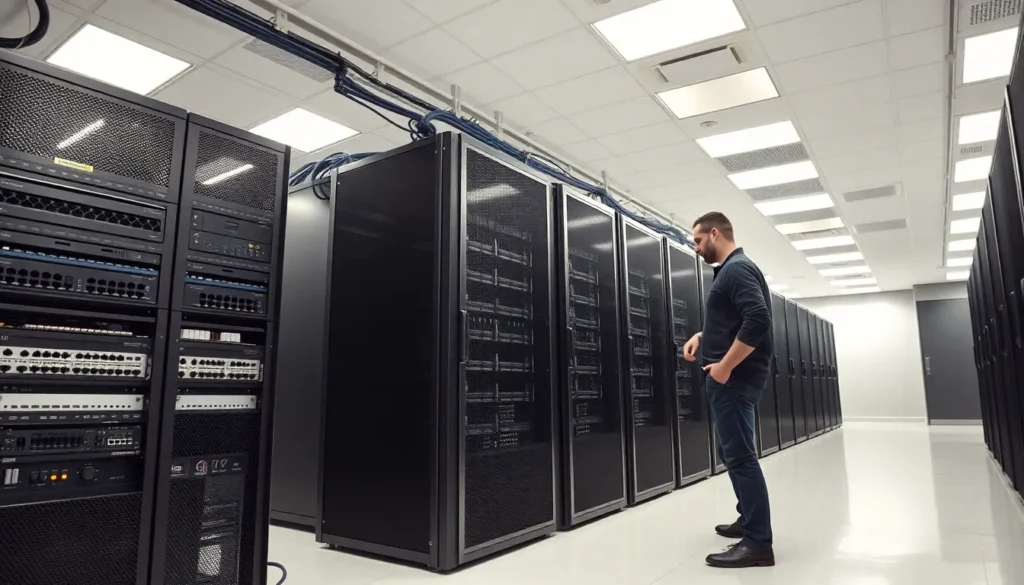In today’s digital age, the backbone of every great website is solid hardware. You might be thinking, ‘Hardware? Isn’t that just for building computers?’ Well, hold onto your keyboards because it’s far more exciting than that. Whether it’s a bustling e-commerce platform or a sleek portfolio site, understanding the nuts and bolts of hardware can make all the difference. Get ready to jump into the thrilling world of hardware web development as we explore the essentials that make your favorite websites tick, and tick well..
Table of Contents
ToggleUnderstanding Hardware in Web Development

When people picture web development, they often visualize the glitzy front-end or the intricate coding behind the scenes. But let’s not ignore the solid foundation tucked away in the server room. Hardware refers to the physical components that make up a server or a network, and without it, websites wouldn’t exist. Think of it as the unsung hero of the tech world.
These components include servers, routers, switches, and all the cables connecting them, essentially everything you can’t see when browsing your favorite sites. Understanding the role of hardware helps developers optimize their applications. As they say, good tools make good work, and in web development, the right hardware will pave the way for smoother operations and faster load times.
Essential Hardware Components for Websites
To create a solid web experience, it’s crucial to understand the essential hardware components involved. Here are some key players in the hardware game:
1. Servers
Servers are the powerhouse of any website. They store, process, and manage web content. From shared hosting environments to dedicated servers, the type you choose depends on your traffic and performance needs.
2. Routers
Routers manage traffic, directing data between the internet and your servers. A strong router ensures that users access your website quickly and efficiently, reducing potential bottlenecks.
3. Switches
Switches connect multiple devices within a network, enabling communication and seamless data transfer. Think of them as traffic lights, controlling how data moves through your internal systems.
4. Storage
Hard drives and SSDs are vital for storing website data. Fast storage solutions significantly speed up load times, benefiting user experience and SEO rankings.
These components can make or break a website’s performance, so choosing wisely is essential.
Optimizing Hardware for Performance
To stretch the limits of what your hardware can do, optimization is key. Start by evaluating your current setup. Are you experiencing slow load times? Is your server struggling under user demand? Here are some strategies to enhance performance:
1. Upgrade Hardware
Invest in newer, faster components. Sometimes existing hardware isn’t up to par: upgrading can provide a significant boost in performance.
2. Load Balancing
Distributing traffic across several servers can prevent overload on a single unit. This technique equates to multiple lanes on a highway: it allows for smoother traffic flow.
3. Regular Maintenance
Running checks and ensuring that components operate at peak efficiency can extend the life of your hardware. Dust buildup can create overheating issues, so remember to keep things tidy in the server room.
With these simple steps, any site can see an improvement in speed, reliability, and overall user satisfaction.
Choosing the Right Hardware for Your Needs
Selecting hardware tailored to your specific needs is crucial. Large e-commerce sites will have different requirements compared to a personal blog. Here’s how to navigate your choices:
1. Assess Your Needs
Start by reviewing your current and expected traffic. More visitors mean you’ll need hardware that can handle the load.
2. Analyze Your Content
Heavy content, such as videos and high-resolution images, requires more storage and bandwidth. Choose hardware equipped to manage these demands.
3. Consider Scalability
As your site grows, so will your hardware demands. Opt for solutions that allow easy upgrades when it’s time to expand.
Setup and Maintenance of Web Server Hardware
Getting your hardware up and running is just the beginning: ongoing maintenance is equally important. Here’s a streamlined approach to setting up and maintaining web server hardware:
1. Setup
When setting up, ensure proper network configurations. The cabling and router placement can significantly affect performance. You also want to install software that monitors your server’s health for unusual activity.
2. Regular Software Updates
Keeping software up-to-date is like giving your hardware a regular health check. It guards against vulnerabilities and optimizes performance.
3. Monitoring Performance
Use performance monitoring tools to detect potential issues early. Track metrics like load times, downtime, and user access patterns to manage hardware effectively.
Future Trends in Hardware for Web Development
As technology evolves, so does hardware. The trends to watch in the coming years include:
1. Cloud Computing
Cloud solutions are rapidly changing how hardware is utilized. Businesses can now access powerful hardware through cloud services without the effort of physical maintenance.
2. Edge Computing
With edge computing, data is processed closer to its source, reducing latency and improving user experiences. This trend is particularly impactful for applications requiring real-time processing.
3. AI and Machine Learning
AI-driven hardware will revolutionize how servers manage operations. Smart systems will optimize performance autonomously, adjusting to user needs efficiently.










